Business Research Design: Ford Motors, Course XYZ, Semester 1
VerifiedAdded on 2022/10/09
|16
|4236
|428
Report
AI Summary
This report presents a comprehensive business research design for Ford Motor Company, analyzing its current market position and proposing strategies for future success. The study begins with an overview of the automotive industry, highlighting key players and competitive dynamics. It then focuses on Ford's strengths and weaknesses, particularly in relation to its customer value proposition. The report integrates insights from articles on customers, innovation, and future trends to develop recommendations for business enhancement. Key areas of focus include redefining the customer value proposition, exploring new partnerships, adapting to the electric vehicle market, and redesigning the business model to improve customer relationships and streamline costs. The research emphasizes the importance of understanding customer needs, embracing innovation, and anticipating future industry shifts to ensure Ford's sustainability and market share in a competitive landscape. The report also includes a business model canvas with key partners, activities, customer relationships, and cost/revenue structures, with recommendations for improvement.
Contribute Materials
Your contribution can guide someone’s learning journey. Share your
documents today.
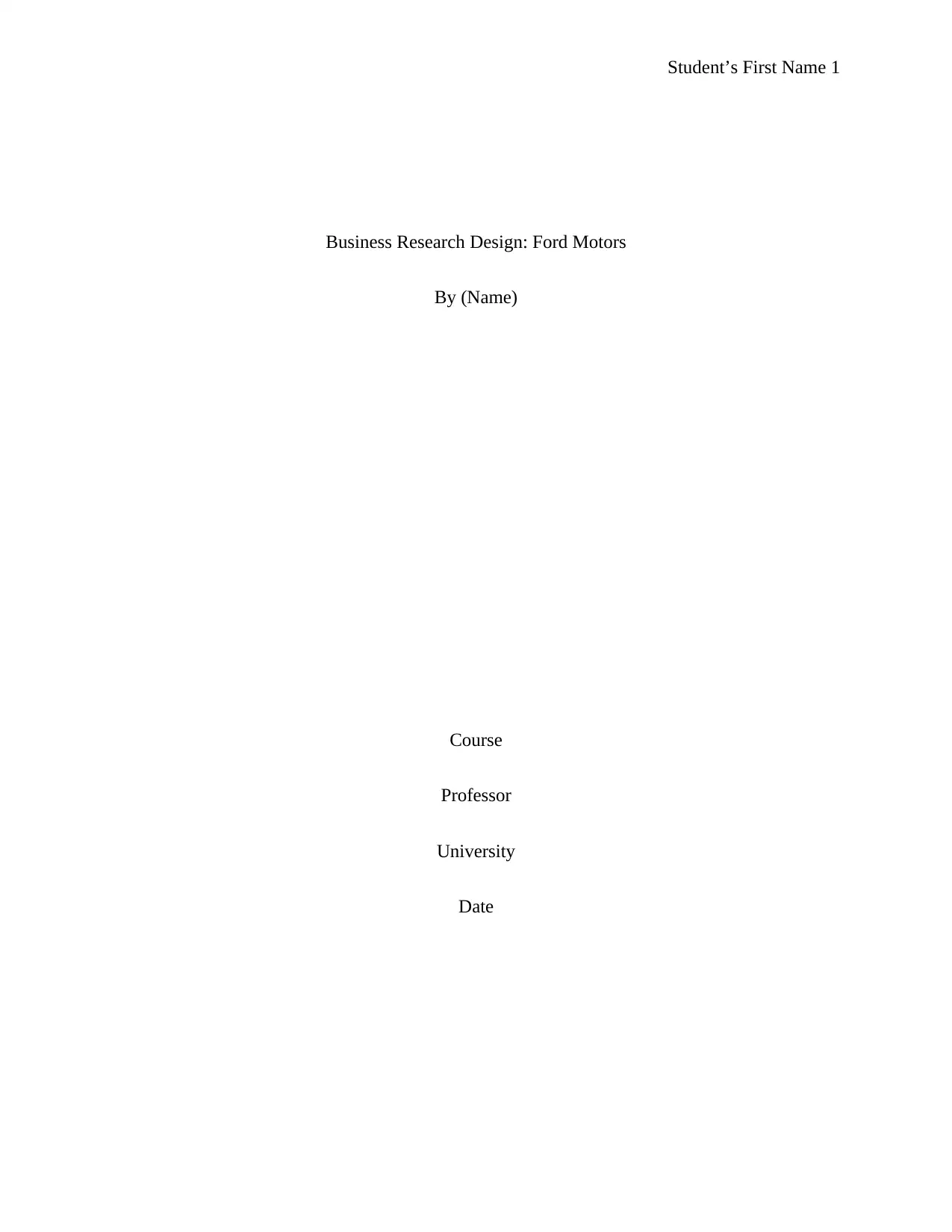
Student’s First Name 1
Business Research Design: Ford Motors
By (Name)
Course
Professor
University
Date
Business Research Design: Ford Motors
By (Name)
Course
Professor
University
Date
Secure Best Marks with AI Grader
Need help grading? Try our AI Grader for instant feedback on your assignments.
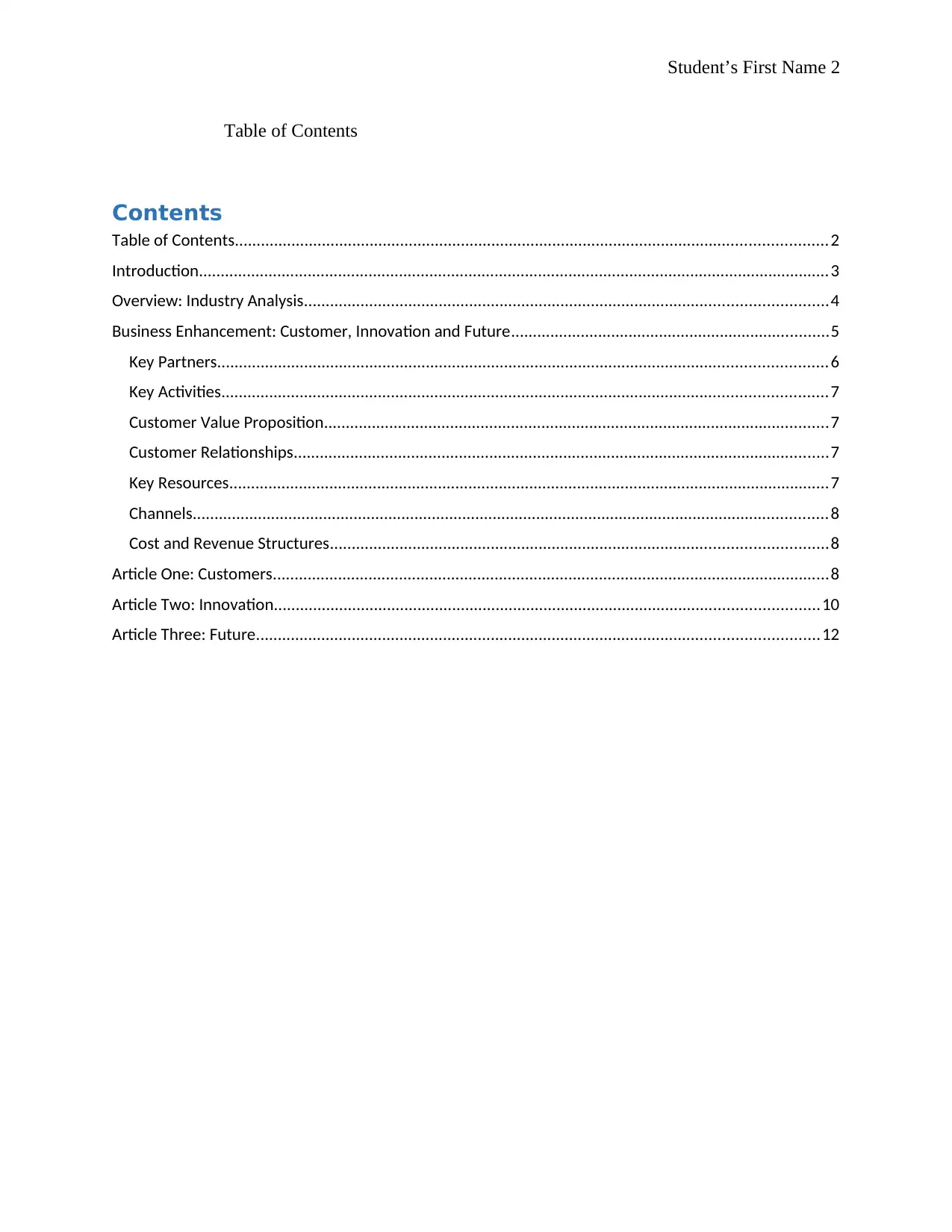
Student’s First Name 2
Table of Contents
Contents
Table of Contents........................................................................................................................................2
Introduction.................................................................................................................................................3
Overview: Industry Analysis........................................................................................................................4
Business Enhancement: Customer, Innovation and Future.........................................................................5
Key Partners............................................................................................................................................6
Key Activities...........................................................................................................................................7
Customer Value Proposition....................................................................................................................7
Customer Relationships...........................................................................................................................7
Key Resources..........................................................................................................................................7
Channels..................................................................................................................................................8
Cost and Revenue Structures..................................................................................................................8
Article One: Customers................................................................................................................................8
Article Two: Innovation.............................................................................................................................10
Article Three: Future.................................................................................................................................12
Table of Contents
Contents
Table of Contents........................................................................................................................................2
Introduction.................................................................................................................................................3
Overview: Industry Analysis........................................................................................................................4
Business Enhancement: Customer, Innovation and Future.........................................................................5
Key Partners............................................................................................................................................6
Key Activities...........................................................................................................................................7
Customer Value Proposition....................................................................................................................7
Customer Relationships...........................................................................................................................7
Key Resources..........................................................................................................................................7
Channels..................................................................................................................................................8
Cost and Revenue Structures..................................................................................................................8
Article One: Customers................................................................................................................................8
Article Two: Innovation.............................................................................................................................10
Article Three: Future.................................................................................................................................12
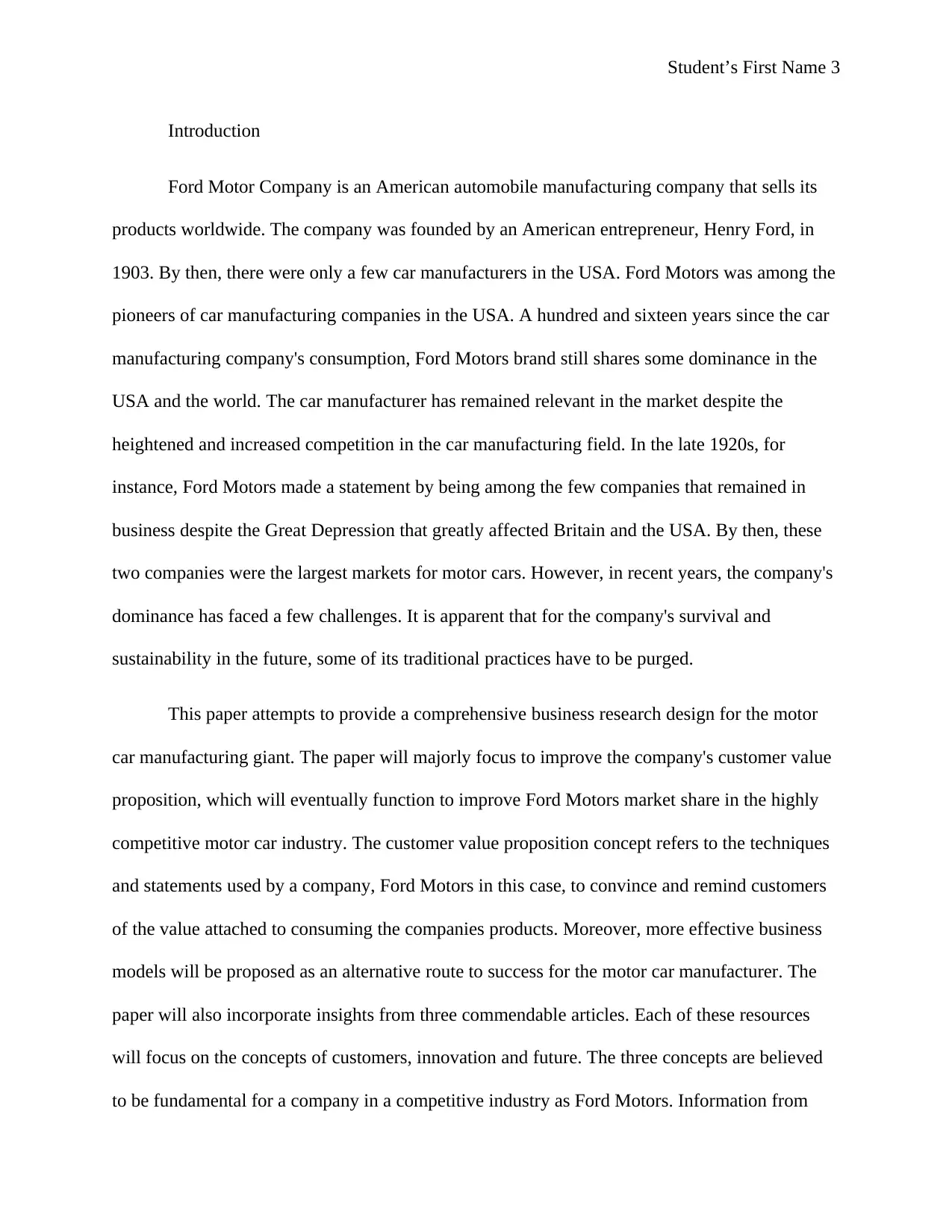
Student’s First Name 3
Introduction
Ford Motor Company is an American automobile manufacturing company that sells its
products worldwide. The company was founded by an American entrepreneur, Henry Ford, in
1903. By then, there were only a few car manufacturers in the USA. Ford Motors was among the
pioneers of car manufacturing companies in the USA. A hundred and sixteen years since the car
manufacturing company's consumption, Ford Motors brand still shares some dominance in the
USA and the world. The car manufacturer has remained relevant in the market despite the
heightened and increased competition in the car manufacturing field. In the late 1920s, for
instance, Ford Motors made a statement by being among the few companies that remained in
business despite the Great Depression that greatly affected Britain and the USA. By then, these
two companies were the largest markets for motor cars. However, in recent years, the company's
dominance has faced a few challenges. It is apparent that for the company's survival and
sustainability in the future, some of its traditional practices have to be purged.
This paper attempts to provide a comprehensive business research design for the motor
car manufacturing giant. The paper will majorly focus to improve the company's customer value
proposition, which will eventually function to improve Ford Motors market share in the highly
competitive motor car industry. The customer value proposition concept refers to the techniques
and statements used by a company, Ford Motors in this case, to convince and remind customers
of the value attached to consuming the companies products. Moreover, more effective business
models will be proposed as an alternative route to success for the motor car manufacturer. The
paper will also incorporate insights from three commendable articles. Each of these resources
will focus on the concepts of customers, innovation and future. The three concepts are believed
to be fundamental for a company in a competitive industry as Ford Motors. Information from
Introduction
Ford Motor Company is an American automobile manufacturing company that sells its
products worldwide. The company was founded by an American entrepreneur, Henry Ford, in
1903. By then, there were only a few car manufacturers in the USA. Ford Motors was among the
pioneers of car manufacturing companies in the USA. A hundred and sixteen years since the car
manufacturing company's consumption, Ford Motors brand still shares some dominance in the
USA and the world. The car manufacturer has remained relevant in the market despite the
heightened and increased competition in the car manufacturing field. In the late 1920s, for
instance, Ford Motors made a statement by being among the few companies that remained in
business despite the Great Depression that greatly affected Britain and the USA. By then, these
two companies were the largest markets for motor cars. However, in recent years, the company's
dominance has faced a few challenges. It is apparent that for the company's survival and
sustainability in the future, some of its traditional practices have to be purged.
This paper attempts to provide a comprehensive business research design for the motor
car manufacturing giant. The paper will majorly focus to improve the company's customer value
proposition, which will eventually function to improve Ford Motors market share in the highly
competitive motor car industry. The customer value proposition concept refers to the techniques
and statements used by a company, Ford Motors in this case, to convince and remind customers
of the value attached to consuming the companies products. Moreover, more effective business
models will be proposed as an alternative route to success for the motor car manufacturer. The
paper will also incorporate insights from three commendable articles. Each of these resources
will focus on the concepts of customers, innovation and future. The three concepts are believed
to be fundamental for a company in a competitive industry as Ford Motors. Information from
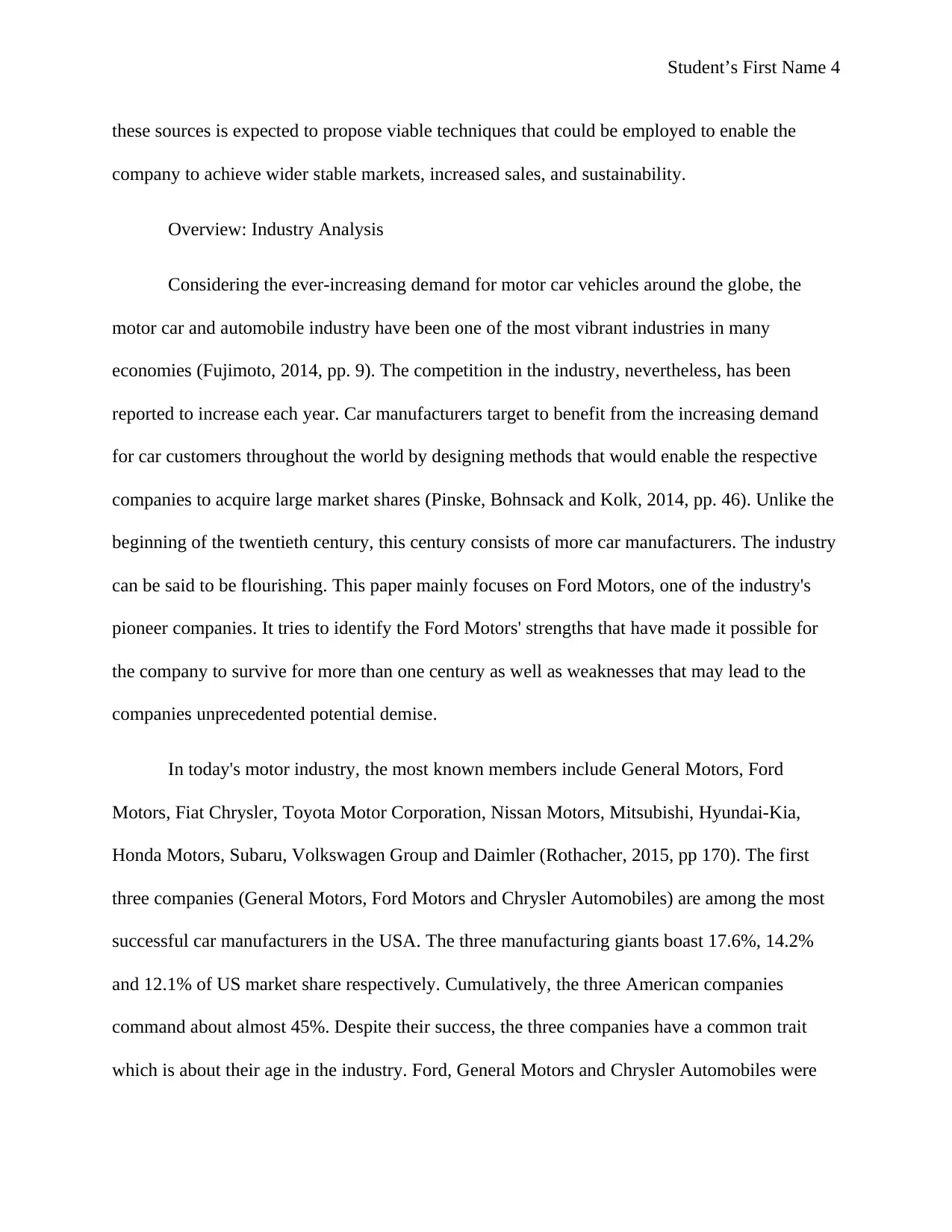
Student’s First Name 4
these sources is expected to propose viable techniques that could be employed to enable the
company to achieve wider stable markets, increased sales, and sustainability.
Overview: Industry Analysis
Considering the ever-increasing demand for motor car vehicles around the globe, the
motor car and automobile industry have been one of the most vibrant industries in many
economies (Fujimoto, 2014, pp. 9). The competition in the industry, nevertheless, has been
reported to increase each year. Car manufacturers target to benefit from the increasing demand
for car customers throughout the world by designing methods that would enable the respective
companies to acquire large market shares (Pinske, Bohnsack and Kolk, 2014, pp. 46). Unlike the
beginning of the twentieth century, this century consists of more car manufacturers. The industry
can be said to be flourishing. This paper mainly focuses on Ford Motors, one of the industry's
pioneer companies. It tries to identify the Ford Motors' strengths that have made it possible for
the company to survive for more than one century as well as weaknesses that may lead to the
companies unprecedented potential demise.
In today's motor industry, the most known members include General Motors, Ford
Motors, Fiat Chrysler, Toyota Motor Corporation, Nissan Motors, Mitsubishi, Hyundai-Kia,
Honda Motors, Subaru, Volkswagen Group and Daimler (Rothacher, 2015, pp 170). The first
three companies (General Motors, Ford Motors and Chrysler Automobiles) are among the most
successful car manufacturers in the USA. The three manufacturing giants boast 17.6%, 14.2%
and 12.1% of US market share respectively. Cumulatively, the three American companies
command about almost 45%. Despite their success, the three companies have a common trait
which is about their age in the industry. Ford, General Motors and Chrysler Automobiles were
these sources is expected to propose viable techniques that could be employed to enable the
company to achieve wider stable markets, increased sales, and sustainability.
Overview: Industry Analysis
Considering the ever-increasing demand for motor car vehicles around the globe, the
motor car and automobile industry have been one of the most vibrant industries in many
economies (Fujimoto, 2014, pp. 9). The competition in the industry, nevertheless, has been
reported to increase each year. Car manufacturers target to benefit from the increasing demand
for car customers throughout the world by designing methods that would enable the respective
companies to acquire large market shares (Pinske, Bohnsack and Kolk, 2014, pp. 46). Unlike the
beginning of the twentieth century, this century consists of more car manufacturers. The industry
can be said to be flourishing. This paper mainly focuses on Ford Motors, one of the industry's
pioneer companies. It tries to identify the Ford Motors' strengths that have made it possible for
the company to survive for more than one century as well as weaknesses that may lead to the
companies unprecedented potential demise.
In today's motor industry, the most known members include General Motors, Ford
Motors, Fiat Chrysler, Toyota Motor Corporation, Nissan Motors, Mitsubishi, Hyundai-Kia,
Honda Motors, Subaru, Volkswagen Group and Daimler (Rothacher, 2015, pp 170). The first
three companies (General Motors, Ford Motors and Chrysler Automobiles) are among the most
successful car manufacturers in the USA. The three manufacturing giants boast 17.6%, 14.2%
and 12.1% of US market share respectively. Cumulatively, the three American companies
command about almost 45%. Despite their success, the three companies have a common trait
which is about their age in the industry. Ford, General Motors and Chrysler Automobiles were
Secure Best Marks with AI Grader
Need help grading? Try our AI Grader for instant feedback on your assignments.
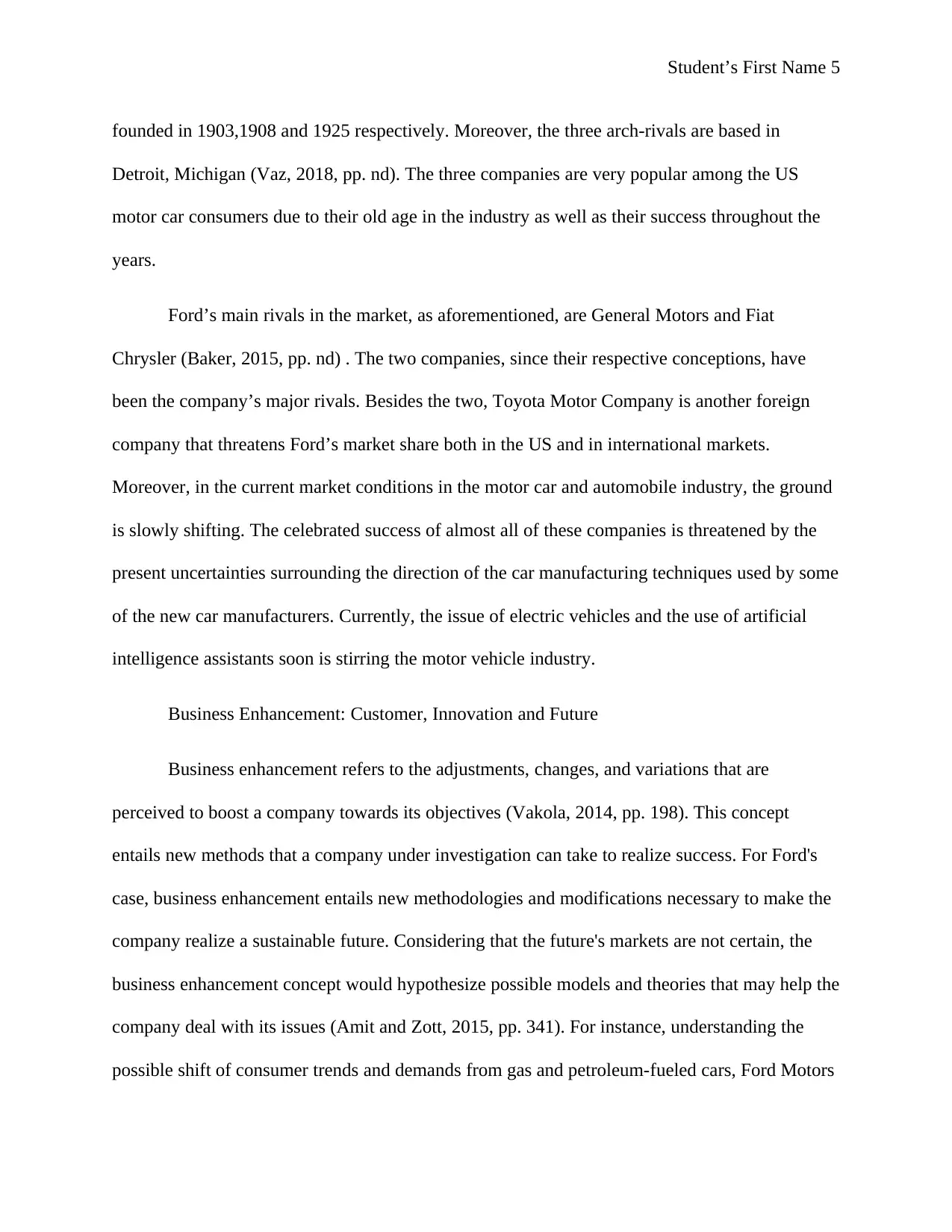
Student’s First Name 5
founded in 1903,1908 and 1925 respectively. Moreover, the three arch-rivals are based in
Detroit, Michigan (Vaz, 2018, pp. nd). The three companies are very popular among the US
motor car consumers due to their old age in the industry as well as their success throughout the
years.
Ford’s main rivals in the market, as aforementioned, are General Motors and Fiat
Chrysler (Baker, 2015, pp. nd) . The two companies, since their respective conceptions, have
been the company’s major rivals. Besides the two, Toyota Motor Company is another foreign
company that threatens Ford’s market share both in the US and in international markets.
Moreover, in the current market conditions in the motor car and automobile industry, the ground
is slowly shifting. The celebrated success of almost all of these companies is threatened by the
present uncertainties surrounding the direction of the car manufacturing techniques used by some
of the new car manufacturers. Currently, the issue of electric vehicles and the use of artificial
intelligence assistants soon is stirring the motor vehicle industry.
Business Enhancement: Customer, Innovation and Future
Business enhancement refers to the adjustments, changes, and variations that are
perceived to boost a company towards its objectives (Vakola, 2014, pp. 198). This concept
entails new methods that a company under investigation can take to realize success. For Ford's
case, business enhancement entails new methodologies and modifications necessary to make the
company realize a sustainable future. Considering that the future's markets are not certain, the
business enhancement concept would hypothesize possible models and theories that may help the
company deal with its issues (Amit and Zott, 2015, pp. 341). For instance, understanding the
possible shift of consumer trends and demands from gas and petroleum-fueled cars, Ford Motors
founded in 1903,1908 and 1925 respectively. Moreover, the three arch-rivals are based in
Detroit, Michigan (Vaz, 2018, pp. nd). The three companies are very popular among the US
motor car consumers due to their old age in the industry as well as their success throughout the
years.
Ford’s main rivals in the market, as aforementioned, are General Motors and Fiat
Chrysler (Baker, 2015, pp. nd) . The two companies, since their respective conceptions, have
been the company’s major rivals. Besides the two, Toyota Motor Company is another foreign
company that threatens Ford’s market share both in the US and in international markets.
Moreover, in the current market conditions in the motor car and automobile industry, the ground
is slowly shifting. The celebrated success of almost all of these companies is threatened by the
present uncertainties surrounding the direction of the car manufacturing techniques used by some
of the new car manufacturers. Currently, the issue of electric vehicles and the use of artificial
intelligence assistants soon is stirring the motor vehicle industry.
Business Enhancement: Customer, Innovation and Future
Business enhancement refers to the adjustments, changes, and variations that are
perceived to boost a company towards its objectives (Vakola, 2014, pp. 198). This concept
entails new methods that a company under investigation can take to realize success. For Ford's
case, business enhancement entails new methodologies and modifications necessary to make the
company realize a sustainable future. Considering that the future's markets are not certain, the
business enhancement concept would hypothesize possible models and theories that may help the
company deal with its issues (Amit and Zott, 2015, pp. 341). For instance, understanding the
possible shift of consumer trends and demands from gas and petroleum-fueled cars, Ford Motors
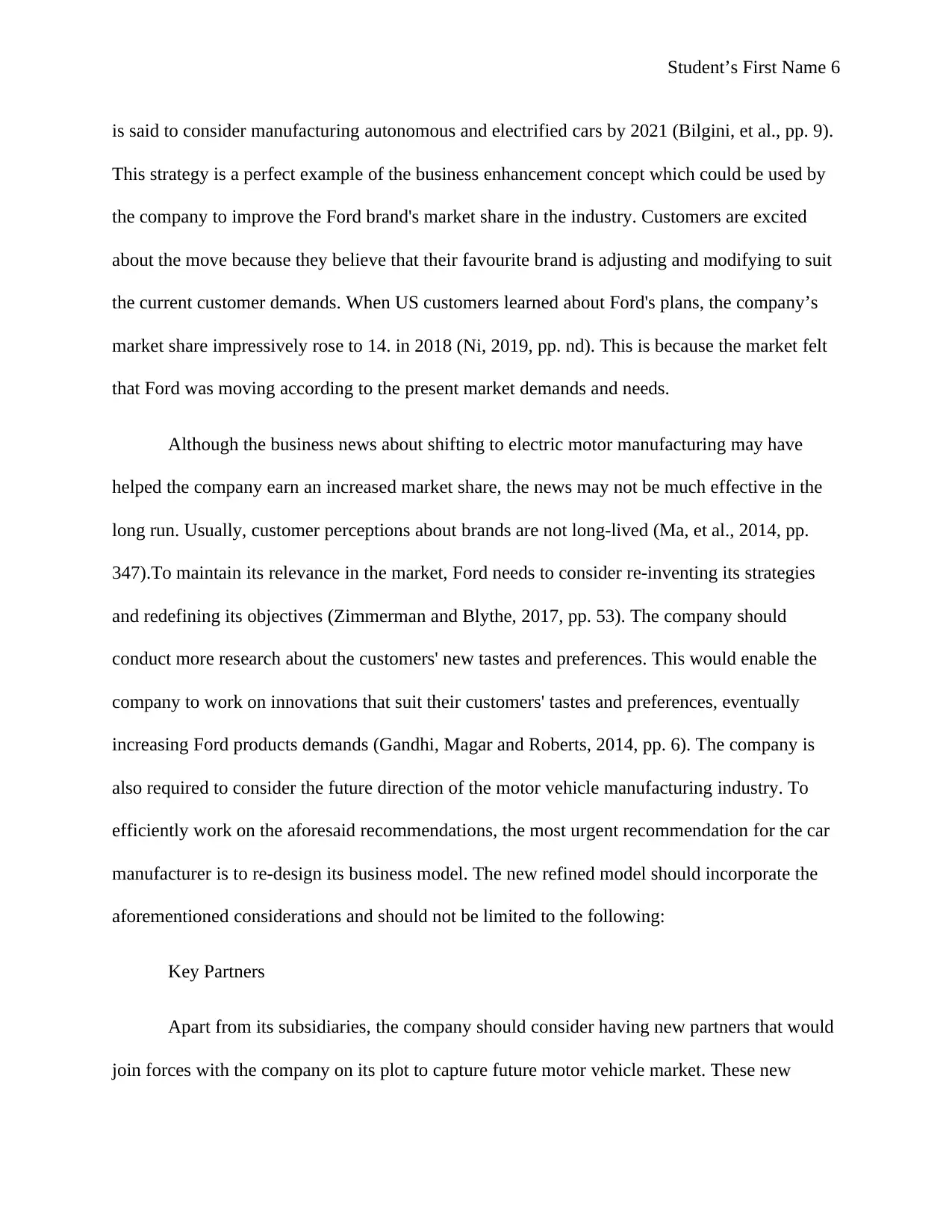
Student’s First Name 6
is said to consider manufacturing autonomous and electrified cars by 2021 (Bilgini, et al., pp. 9).
This strategy is a perfect example of the business enhancement concept which could be used by
the company to improve the Ford brand's market share in the industry. Customers are excited
about the move because they believe that their favourite brand is adjusting and modifying to suit
the current customer demands. When US customers learned about Ford's plans, the company’s
market share impressively rose to 14. in 2018 (Ni, 2019, pp. nd). This is because the market felt
that Ford was moving according to the present market demands and needs.
Although the business news about shifting to electric motor manufacturing may have
helped the company earn an increased market share, the news may not be much effective in the
long run. Usually, customer perceptions about brands are not long-lived (Ma, et al., 2014, pp.
347).To maintain its relevance in the market, Ford needs to consider re-inventing its strategies
and redefining its objectives (Zimmerman and Blythe, 2017, pp. 53). The company should
conduct more research about the customers' new tastes and preferences. This would enable the
company to work on innovations that suit their customers' tastes and preferences, eventually
increasing Ford products demands (Gandhi, Magar and Roberts, 2014, pp. 6). The company is
also required to consider the future direction of the motor vehicle manufacturing industry. To
efficiently work on the aforesaid recommendations, the most urgent recommendation for the car
manufacturer is to re-design its business model. The new refined model should incorporate the
aforementioned considerations and should not be limited to the following:
Key Partners
Apart from its subsidiaries, the company should consider having new partners that would
join forces with the company on its plot to capture future motor vehicle market. These new
is said to consider manufacturing autonomous and electrified cars by 2021 (Bilgini, et al., pp. 9).
This strategy is a perfect example of the business enhancement concept which could be used by
the company to improve the Ford brand's market share in the industry. Customers are excited
about the move because they believe that their favourite brand is adjusting and modifying to suit
the current customer demands. When US customers learned about Ford's plans, the company’s
market share impressively rose to 14. in 2018 (Ni, 2019, pp. nd). This is because the market felt
that Ford was moving according to the present market demands and needs.
Although the business news about shifting to electric motor manufacturing may have
helped the company earn an increased market share, the news may not be much effective in the
long run. Usually, customer perceptions about brands are not long-lived (Ma, et al., 2014, pp.
347).To maintain its relevance in the market, Ford needs to consider re-inventing its strategies
and redefining its objectives (Zimmerman and Blythe, 2017, pp. 53). The company should
conduct more research about the customers' new tastes and preferences. This would enable the
company to work on innovations that suit their customers' tastes and preferences, eventually
increasing Ford products demands (Gandhi, Magar and Roberts, 2014, pp. 6). The company is
also required to consider the future direction of the motor vehicle manufacturing industry. To
efficiently work on the aforesaid recommendations, the most urgent recommendation for the car
manufacturer is to re-design its business model. The new refined model should incorporate the
aforementioned considerations and should not be limited to the following:
Key Partners
Apart from its subsidiaries, the company should consider having new partners that would
join forces with the company on its plot to capture future motor vehicle market. These new
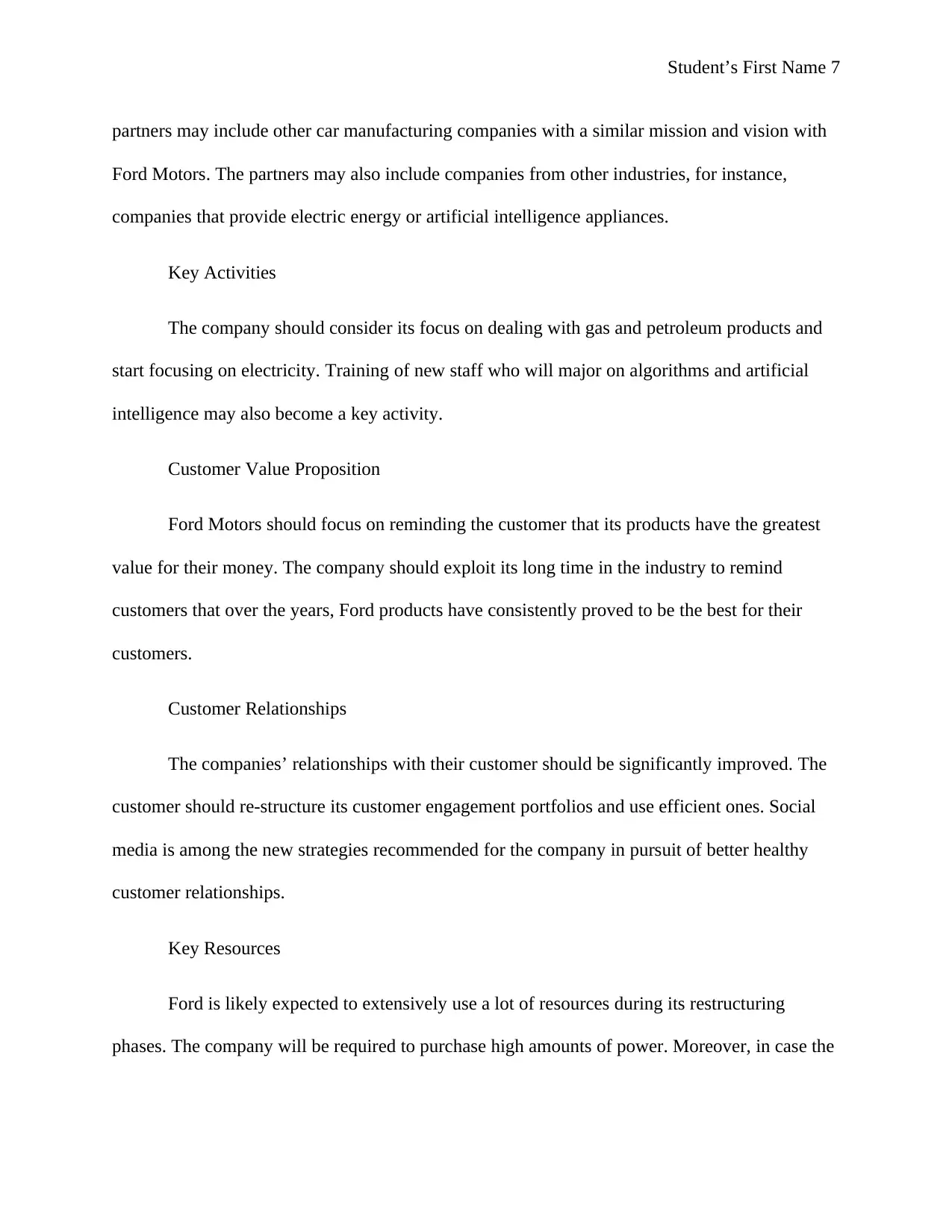
Student’s First Name 7
partners may include other car manufacturing companies with a similar mission and vision with
Ford Motors. The partners may also include companies from other industries, for instance,
companies that provide electric energy or artificial intelligence appliances.
Key Activities
The company should consider its focus on dealing with gas and petroleum products and
start focusing on electricity. Training of new staff who will major on algorithms and artificial
intelligence may also become a key activity.
Customer Value Proposition
Ford Motors should focus on reminding the customer that its products have the greatest
value for their money. The company should exploit its long time in the industry to remind
customers that over the years, Ford products have consistently proved to be the best for their
customers.
Customer Relationships
The companies’ relationships with their customer should be significantly improved. The
customer should re-structure its customer engagement portfolios and use efficient ones. Social
media is among the new strategies recommended for the company in pursuit of better healthy
customer relationships.
Key Resources
Ford is likely expected to extensively use a lot of resources during its restructuring
phases. The company will be required to purchase high amounts of power. Moreover, in case the
partners may include other car manufacturing companies with a similar mission and vision with
Ford Motors. The partners may also include companies from other industries, for instance,
companies that provide electric energy or artificial intelligence appliances.
Key Activities
The company should consider its focus on dealing with gas and petroleum products and
start focusing on electricity. Training of new staff who will major on algorithms and artificial
intelligence may also become a key activity.
Customer Value Proposition
Ford Motors should focus on reminding the customer that its products have the greatest
value for their money. The company should exploit its long time in the industry to remind
customers that over the years, Ford products have consistently proved to be the best for their
customers.
Customer Relationships
The companies’ relationships with their customer should be significantly improved. The
customer should re-structure its customer engagement portfolios and use efficient ones. Social
media is among the new strategies recommended for the company in pursuit of better healthy
customer relationships.
Key Resources
Ford is likely expected to extensively use a lot of resources during its restructuring
phases. The company will be required to purchase high amounts of power. Moreover, in case the
Paraphrase This Document
Need a fresh take? Get an instant paraphrase of this document with our AI Paraphraser
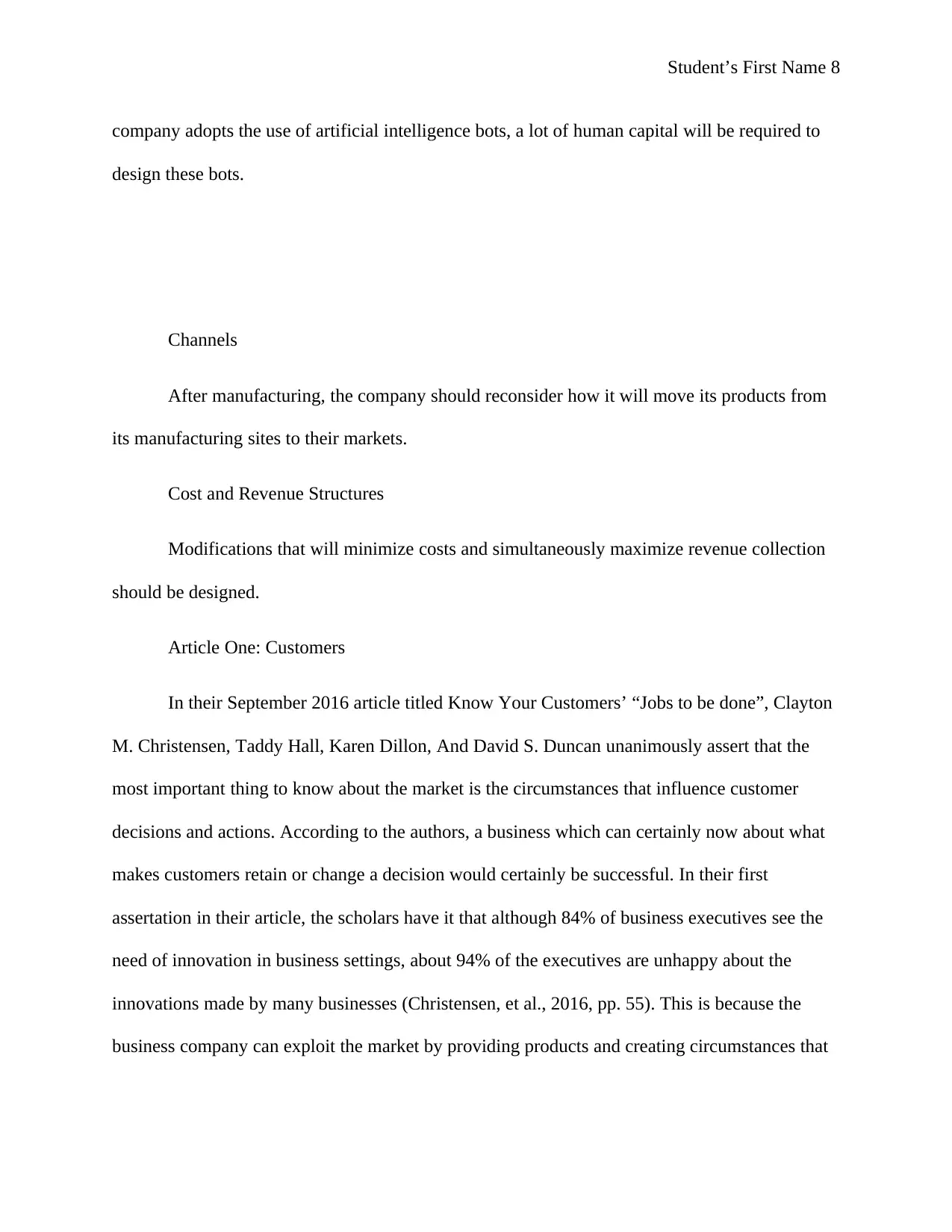
Student’s First Name 8
company adopts the use of artificial intelligence bots, a lot of human capital will be required to
design these bots.
Channels
After manufacturing, the company should reconsider how it will move its products from
its manufacturing sites to their markets.
Cost and Revenue Structures
Modifications that will minimize costs and simultaneously maximize revenue collection
should be designed.
Article One: Customers
In their September 2016 article titled Know Your Customers’ “Jobs to be done”, Clayton
M. Christensen, Taddy Hall, Karen Dillon, And David S. Duncan unanimously assert that the
most important thing to know about the market is the circumstances that influence customer
decisions and actions. According to the authors, a business which can certainly now about what
makes customers retain or change a decision would certainly be successful. In their first
assertation in their article, the scholars have it that although 84% of business executives see the
need of innovation in business settings, about 94% of the executives are unhappy about the
innovations made by many businesses (Christensen, et al., 2016, pp. 55). This is because the
business company can exploit the market by providing products and creating circumstances that
company adopts the use of artificial intelligence bots, a lot of human capital will be required to
design these bots.
Channels
After manufacturing, the company should reconsider how it will move its products from
its manufacturing sites to their markets.
Cost and Revenue Structures
Modifications that will minimize costs and simultaneously maximize revenue collection
should be designed.
Article One: Customers
In their September 2016 article titled Know Your Customers’ “Jobs to be done”, Clayton
M. Christensen, Taddy Hall, Karen Dillon, And David S. Duncan unanimously assert that the
most important thing to know about the market is the circumstances that influence customer
decisions and actions. According to the authors, a business which can certainly now about what
makes customers retain or change a decision would certainly be successful. In their first
assertation in their article, the scholars have it that although 84% of business executives see the
need of innovation in business settings, about 94% of the executives are unhappy about the
innovations made by many businesses (Christensen, et al., 2016, pp. 55). This is because the
business company can exploit the market by providing products and creating circumstances that
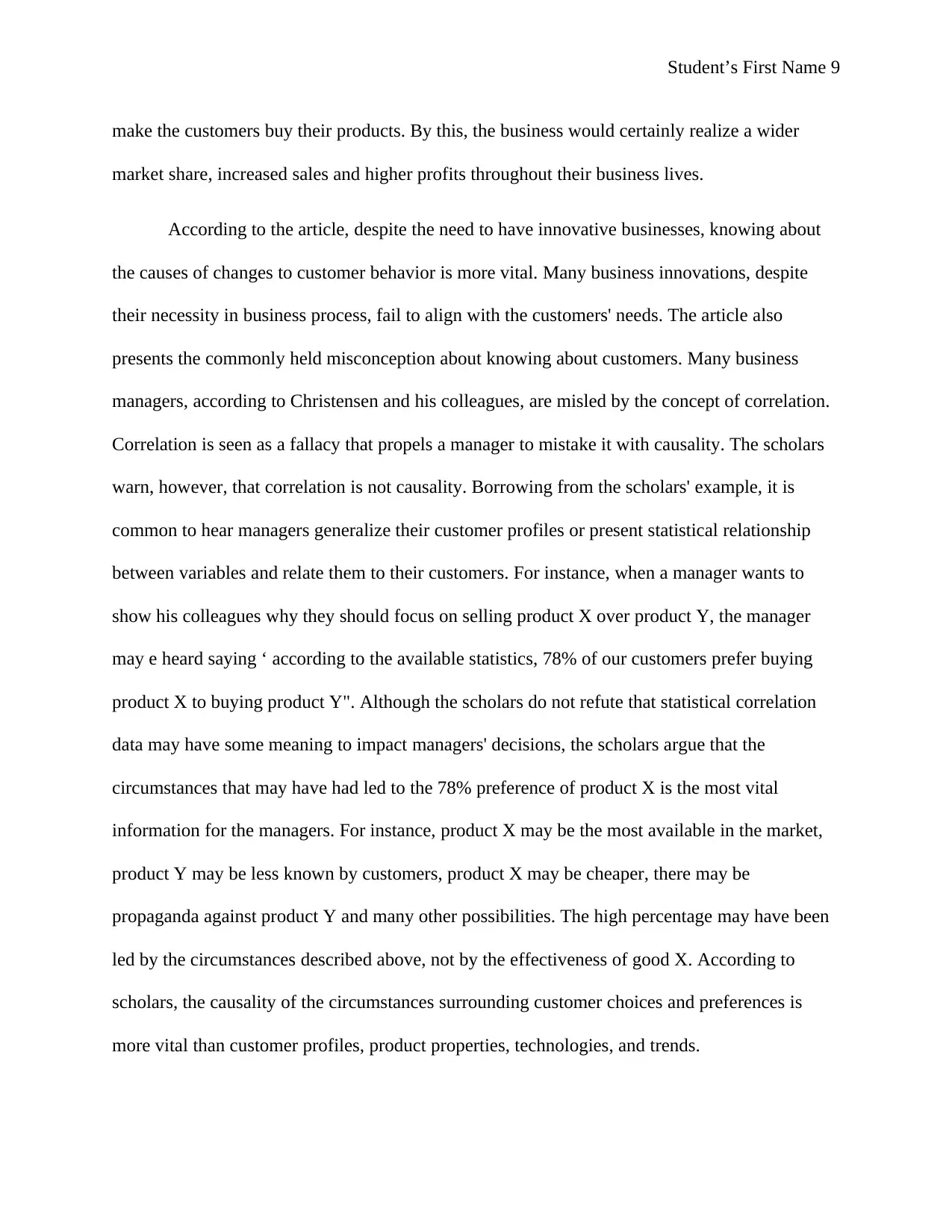
Student’s First Name 9
make the customers buy their products. By this, the business would certainly realize a wider
market share, increased sales and higher profits throughout their business lives.
According to the article, despite the need to have innovative businesses, knowing about
the causes of changes to customer behavior is more vital. Many business innovations, despite
their necessity in business process, fail to align with the customers' needs. The article also
presents the commonly held misconception about knowing about customers. Many business
managers, according to Christensen and his colleagues, are misled by the concept of correlation.
Correlation is seen as a fallacy that propels a manager to mistake it with causality. The scholars
warn, however, that correlation is not causality. Borrowing from the scholars' example, it is
common to hear managers generalize their customer profiles or present statistical relationship
between variables and relate them to their customers. For instance, when a manager wants to
show his colleagues why they should focus on selling product X over product Y, the manager
may e heard saying ‘ according to the available statistics, 78% of our customers prefer buying
product X to buying product Y". Although the scholars do not refute that statistical correlation
data may have some meaning to impact managers' decisions, the scholars argue that the
circumstances that may have had led to the 78% preference of product X is the most vital
information for the managers. For instance, product X may be the most available in the market,
product Y may be less known by customers, product X may be cheaper, there may be
propaganda against product Y and many other possibilities. The high percentage may have been
led by the circumstances described above, not by the effectiveness of good X. According to
scholars, the causality of the circumstances surrounding customer choices and preferences is
more vital than customer profiles, product properties, technologies, and trends.
make the customers buy their products. By this, the business would certainly realize a wider
market share, increased sales and higher profits throughout their business lives.
According to the article, despite the need to have innovative businesses, knowing about
the causes of changes to customer behavior is more vital. Many business innovations, despite
their necessity in business process, fail to align with the customers' needs. The article also
presents the commonly held misconception about knowing about customers. Many business
managers, according to Christensen and his colleagues, are misled by the concept of correlation.
Correlation is seen as a fallacy that propels a manager to mistake it with causality. The scholars
warn, however, that correlation is not causality. Borrowing from the scholars' example, it is
common to hear managers generalize their customer profiles or present statistical relationship
between variables and relate them to their customers. For instance, when a manager wants to
show his colleagues why they should focus on selling product X over product Y, the manager
may e heard saying ‘ according to the available statistics, 78% of our customers prefer buying
product X to buying product Y". Although the scholars do not refute that statistical correlation
data may have some meaning to impact managers' decisions, the scholars argue that the
circumstances that may have had led to the 78% preference of product X is the most vital
information for the managers. For instance, product X may be the most available in the market,
product Y may be less known by customers, product X may be cheaper, there may be
propaganda against product Y and many other possibilities. The high percentage may have been
led by the circumstances described above, not by the effectiveness of good X. According to
scholars, the causality of the circumstances surrounding customer choices and preferences is
more vital than customer profiles, product properties, technologies, and trends.
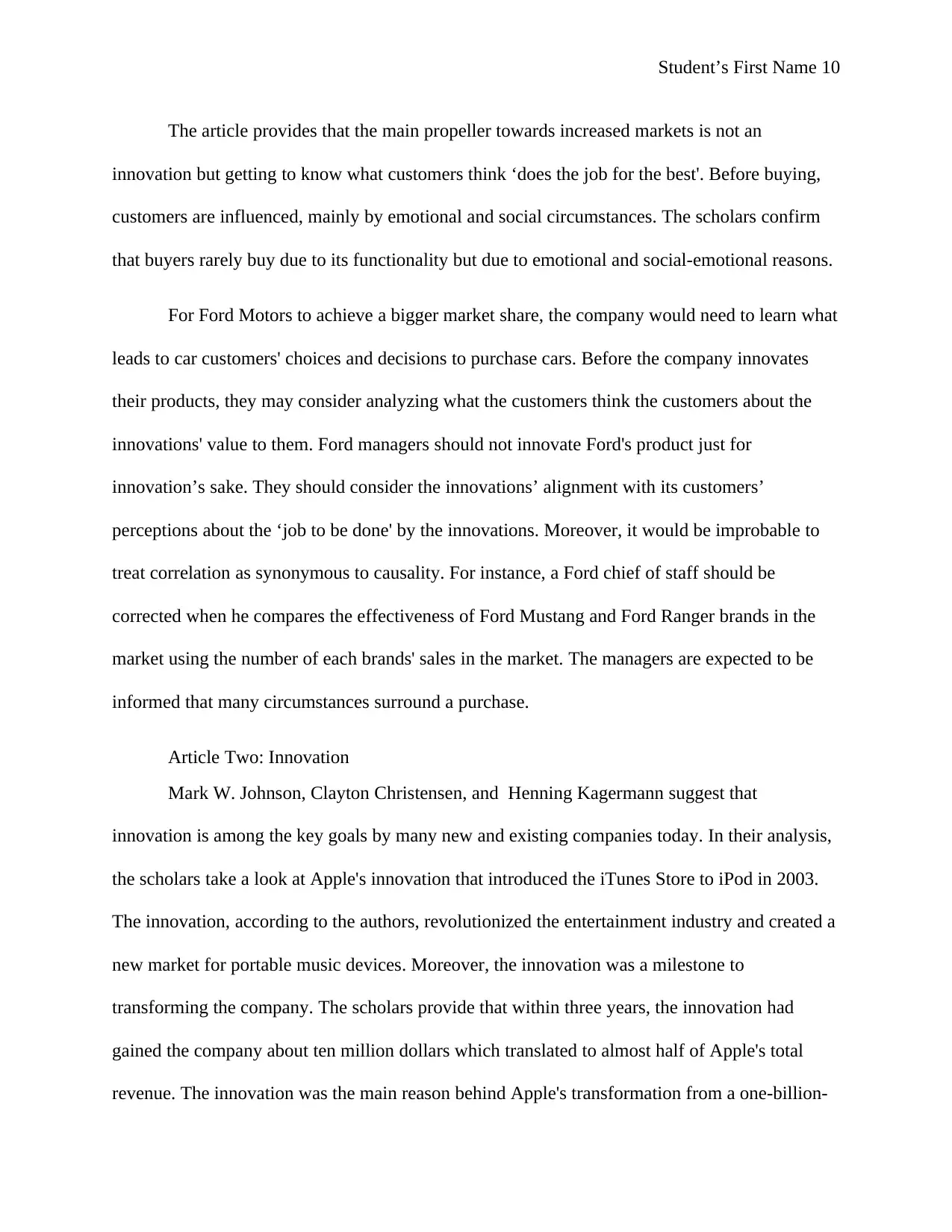
Student’s First Name 10
The article provides that the main propeller towards increased markets is not an
innovation but getting to know what customers think ‘does the job for the best'. Before buying,
customers are influenced, mainly by emotional and social circumstances. The scholars confirm
that buyers rarely buy due to its functionality but due to emotional and social-emotional reasons.
For Ford Motors to achieve a bigger market share, the company would need to learn what
leads to car customers' choices and decisions to purchase cars. Before the company innovates
their products, they may consider analyzing what the customers think the customers about the
innovations' value to them. Ford managers should not innovate Ford's product just for
innovation’s sake. They should consider the innovations’ alignment with its customers’
perceptions about the ‘job to be done' by the innovations. Moreover, it would be improbable to
treat correlation as synonymous to causality. For instance, a Ford chief of staff should be
corrected when he compares the effectiveness of Ford Mustang and Ford Ranger brands in the
market using the number of each brands' sales in the market. The managers are expected to be
informed that many circumstances surround a purchase.
Article Two: Innovation
Mark W. Johnson, Clayton Christensen, and Henning Kagermann suggest that
innovation is among the key goals by many new and existing companies today. In their analysis,
the scholars take a look at Apple's innovation that introduced the iTunes Store to iPod in 2003.
The innovation, according to the authors, revolutionized the entertainment industry and created a
new market for portable music devices. Moreover, the innovation was a milestone to
transforming the company. The scholars provide that within three years, the innovation had
gained the company about ten million dollars which translated to almost half of Apple's total
revenue. The innovation was the main reason behind Apple's transformation from a one-billion-
The article provides that the main propeller towards increased markets is not an
innovation but getting to know what customers think ‘does the job for the best'. Before buying,
customers are influenced, mainly by emotional and social circumstances. The scholars confirm
that buyers rarely buy due to its functionality but due to emotional and social-emotional reasons.
For Ford Motors to achieve a bigger market share, the company would need to learn what
leads to car customers' choices and decisions to purchase cars. Before the company innovates
their products, they may consider analyzing what the customers think the customers about the
innovations' value to them. Ford managers should not innovate Ford's product just for
innovation’s sake. They should consider the innovations’ alignment with its customers’
perceptions about the ‘job to be done' by the innovations. Moreover, it would be improbable to
treat correlation as synonymous to causality. For instance, a Ford chief of staff should be
corrected when he compares the effectiveness of Ford Mustang and Ford Ranger brands in the
market using the number of each brands' sales in the market. The managers are expected to be
informed that many circumstances surround a purchase.
Article Two: Innovation
Mark W. Johnson, Clayton Christensen, and Henning Kagermann suggest that
innovation is among the key goals by many new and existing companies today. In their analysis,
the scholars take a look at Apple's innovation that introduced the iTunes Store to iPod in 2003.
The innovation, according to the authors, revolutionized the entertainment industry and created a
new market for portable music devices. Moreover, the innovation was a milestone to
transforming the company. The scholars provide that within three years, the innovation had
gained the company about ten million dollars which translated to almost half of Apple's total
revenue. The innovation was the main reason behind Apple's transformation from a one-billion-
Secure Best Marks with AI Grader
Need help grading? Try our AI Grader for instant feedback on your assignments.
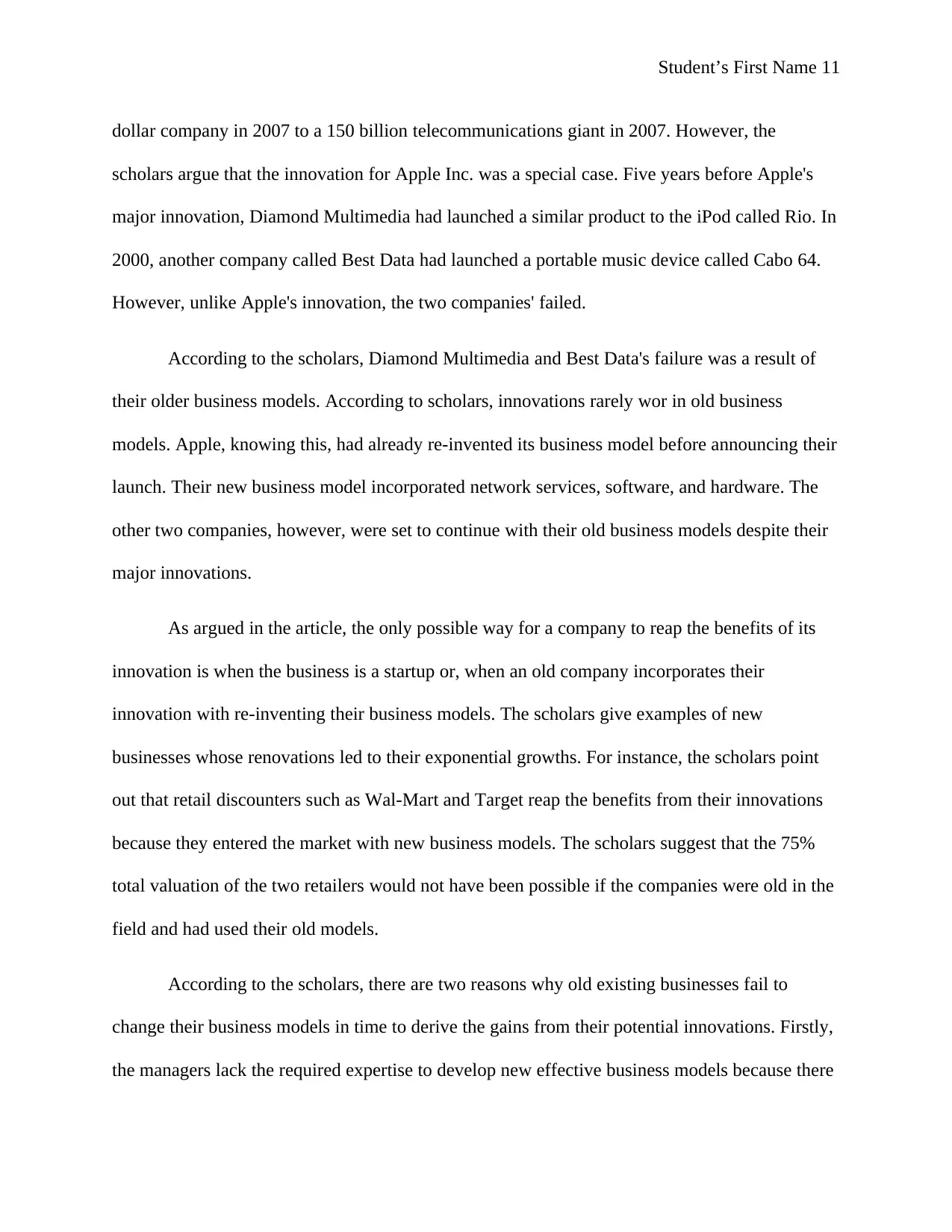
Student’s First Name 11
dollar company in 2007 to a 150 billion telecommunications giant in 2007. However, the
scholars argue that the innovation for Apple Inc. was a special case. Five years before Apple's
major innovation, Diamond Multimedia had launched a similar product to the iPod called Rio. In
2000, another company called Best Data had launched a portable music device called Cabo 64.
However, unlike Apple's innovation, the two companies' failed.
According to the scholars, Diamond Multimedia and Best Data's failure was a result of
their older business models. According to scholars, innovations rarely wor in old business
models. Apple, knowing this, had already re-invented its business model before announcing their
launch. Their new business model incorporated network services, software, and hardware. The
other two companies, however, were set to continue with their old business models despite their
major innovations.
As argued in the article, the only possible way for a company to reap the benefits of its
innovation is when the business is a startup or, when an old company incorporates their
innovation with re-inventing their business models. The scholars give examples of new
businesses whose renovations led to their exponential growths. For instance, the scholars point
out that retail discounters such as Wal-Mart and Target reap the benefits from their innovations
because they entered the market with new business models. The scholars suggest that the 75%
total valuation of the two retailers would not have been possible if the companies were old in the
field and had used their old models.
According to the scholars, there are two reasons why old existing businesses fail to
change their business models in time to derive the gains from their potential innovations. Firstly,
the managers lack the required expertise to develop new effective business models because there
dollar company in 2007 to a 150 billion telecommunications giant in 2007. However, the
scholars argue that the innovation for Apple Inc. was a special case. Five years before Apple's
major innovation, Diamond Multimedia had launched a similar product to the iPod called Rio. In
2000, another company called Best Data had launched a portable music device called Cabo 64.
However, unlike Apple's innovation, the two companies' failed.
According to the scholars, Diamond Multimedia and Best Data's failure was a result of
their older business models. According to scholars, innovations rarely wor in old business
models. Apple, knowing this, had already re-invented its business model before announcing their
launch. Their new business model incorporated network services, software, and hardware. The
other two companies, however, were set to continue with their old business models despite their
major innovations.
As argued in the article, the only possible way for a company to reap the benefits of its
innovation is when the business is a startup or, when an old company incorporates their
innovation with re-inventing their business models. The scholars give examples of new
businesses whose renovations led to their exponential growths. For instance, the scholars point
out that retail discounters such as Wal-Mart and Target reap the benefits from their innovations
because they entered the market with new business models. The scholars suggest that the 75%
total valuation of the two retailers would not have been possible if the companies were old in the
field and had used their old models.
According to the scholars, there are two reasons why old existing businesses fail to
change their business models in time to derive the gains from their potential innovations. Firstly,
the managers lack the required expertise to develop new effective business models because there
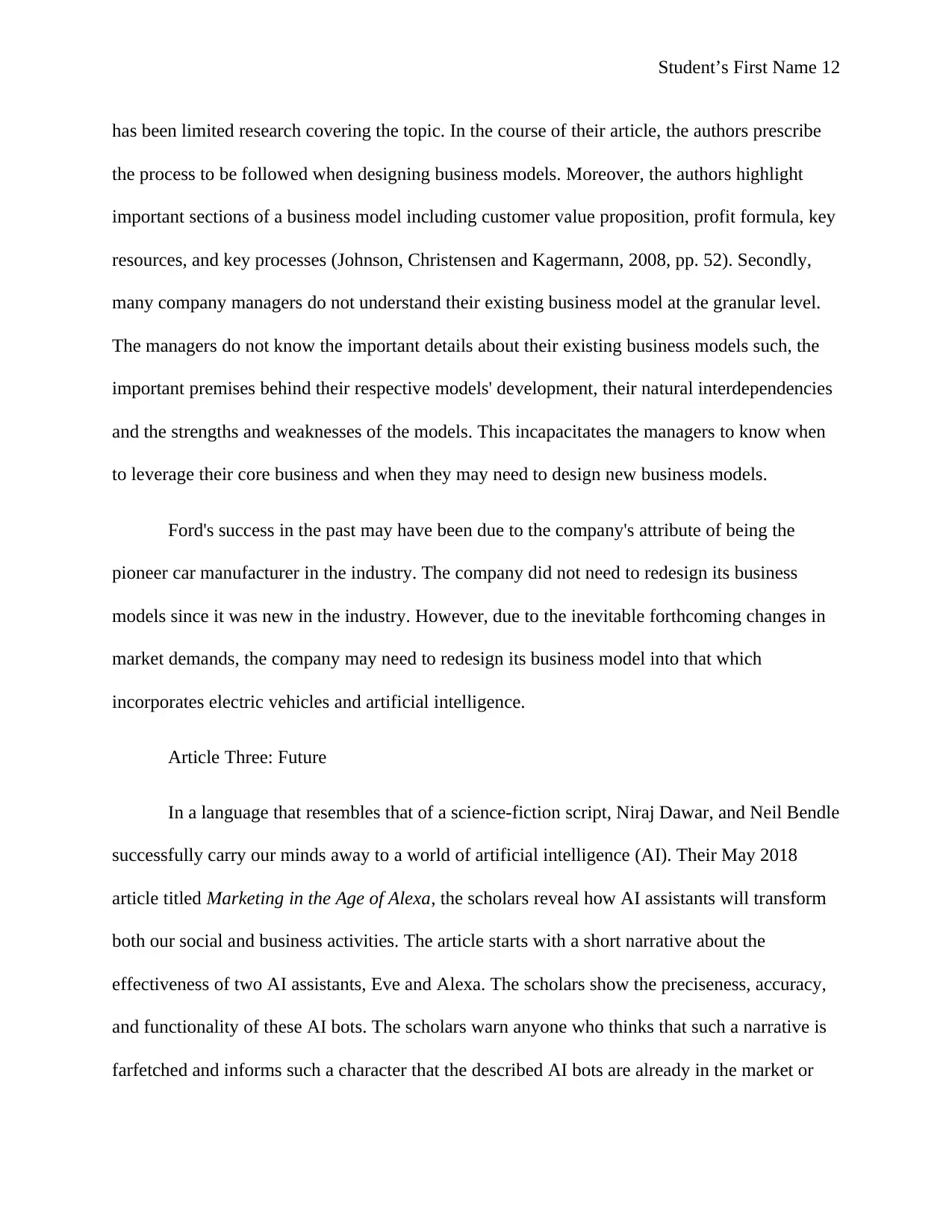
Student’s First Name 12
has been limited research covering the topic. In the course of their article, the authors prescribe
the process to be followed when designing business models. Moreover, the authors highlight
important sections of a business model including customer value proposition, profit formula, key
resources, and key processes (Johnson, Christensen and Kagermann, 2008, pp. 52). Secondly,
many company managers do not understand their existing business model at the granular level.
The managers do not know the important details about their existing business models such, the
important premises behind their respective models' development, their natural interdependencies
and the strengths and weaknesses of the models. This incapacitates the managers to know when
to leverage their core business and when they may need to design new business models.
Ford's success in the past may have been due to the company's attribute of being the
pioneer car manufacturer in the industry. The company did not need to redesign its business
models since it was new in the industry. However, due to the inevitable forthcoming changes in
market demands, the company may need to redesign its business model into that which
incorporates electric vehicles and artificial intelligence.
Article Three: Future
In a language that resembles that of a science-fiction script, Niraj Dawar, and Neil Bendle
successfully carry our minds away to a world of artificial intelligence (AI). Their May 2018
article titled Marketing in the Age of Alexa, the scholars reveal how AI assistants will transform
both our social and business activities. The article starts with a short narrative about the
effectiveness of two AI assistants, Eve and Alexa. The scholars show the preciseness, accuracy,
and functionality of these AI bots. The scholars warn anyone who thinks that such a narrative is
farfetched and informs such a character that the described AI bots are already in the market or
has been limited research covering the topic. In the course of their article, the authors prescribe
the process to be followed when designing business models. Moreover, the authors highlight
important sections of a business model including customer value proposition, profit formula, key
resources, and key processes (Johnson, Christensen and Kagermann, 2008, pp. 52). Secondly,
many company managers do not understand their existing business model at the granular level.
The managers do not know the important details about their existing business models such, the
important premises behind their respective models' development, their natural interdependencies
and the strengths and weaknesses of the models. This incapacitates the managers to know when
to leverage their core business and when they may need to design new business models.
Ford's success in the past may have been due to the company's attribute of being the
pioneer car manufacturer in the industry. The company did not need to redesign its business
models since it was new in the industry. However, due to the inevitable forthcoming changes in
market demands, the company may need to redesign its business model into that which
incorporates electric vehicles and artificial intelligence.
Article Three: Future
In a language that resembles that of a science-fiction script, Niraj Dawar, and Neil Bendle
successfully carry our minds away to a world of artificial intelligence (AI). Their May 2018
article titled Marketing in the Age of Alexa, the scholars reveal how AI assistants will transform
both our social and business activities. The article starts with a short narrative about the
effectiveness of two AI assistants, Eve and Alexa. The scholars show the preciseness, accuracy,
and functionality of these AI bots. The scholars warn anyone who thinks that such a narrative is
farfetched and informs such a character that the described AI bots are already in the market or
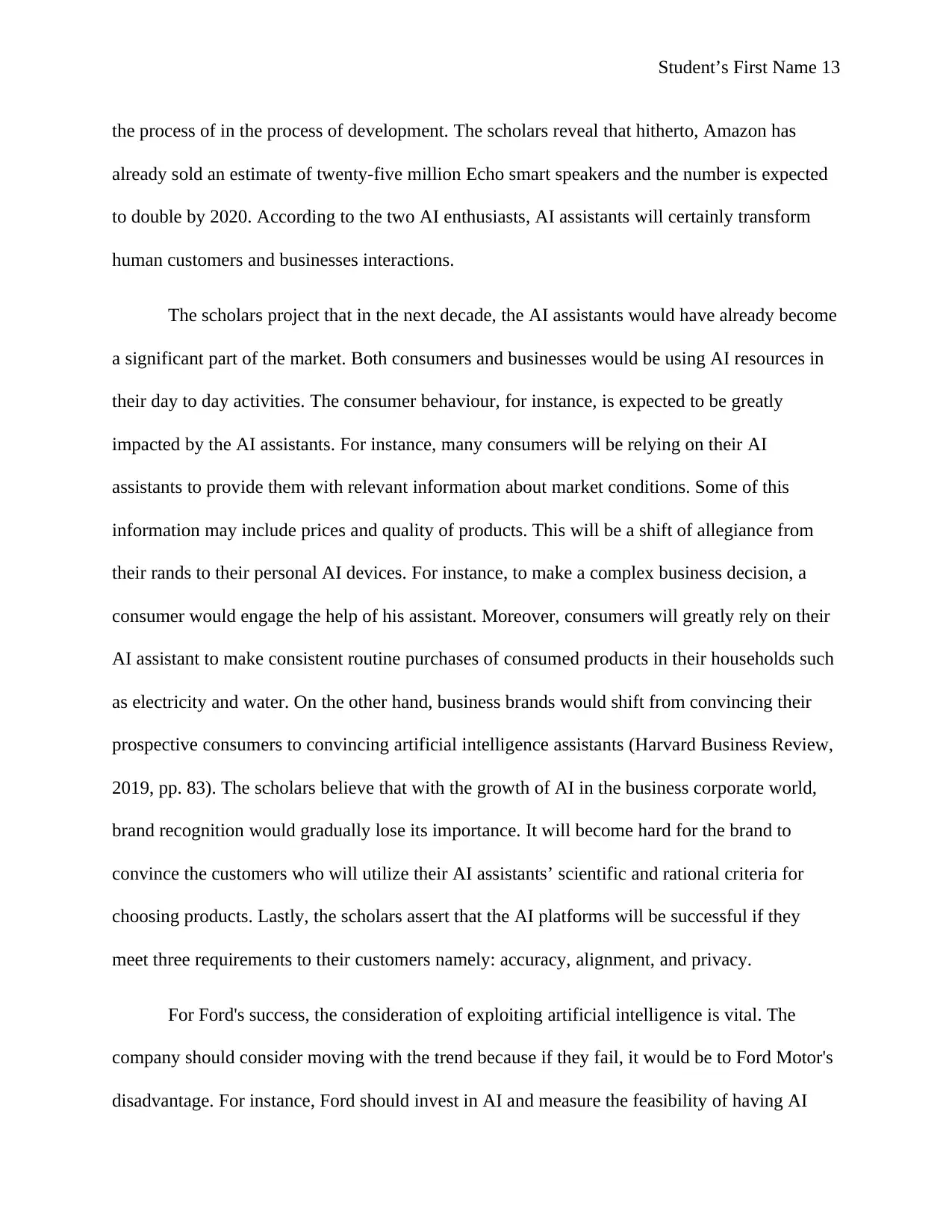
Student’s First Name 13
the process of in the process of development. The scholars reveal that hitherto, Amazon has
already sold an estimate of twenty-five million Echo smart speakers and the number is expected
to double by 2020. According to the two AI enthusiasts, AI assistants will certainly transform
human customers and businesses interactions.
The scholars project that in the next decade, the AI assistants would have already become
a significant part of the market. Both consumers and businesses would be using AI resources in
their day to day activities. The consumer behaviour, for instance, is expected to be greatly
impacted by the AI assistants. For instance, many consumers will be relying on their AI
assistants to provide them with relevant information about market conditions. Some of this
information may include prices and quality of products. This will be a shift of allegiance from
their rands to their personal AI devices. For instance, to make a complex business decision, a
consumer would engage the help of his assistant. Moreover, consumers will greatly rely on their
AI assistant to make consistent routine purchases of consumed products in their households such
as electricity and water. On the other hand, business brands would shift from convincing their
prospective consumers to convincing artificial intelligence assistants (Harvard Business Review,
2019, pp. 83). The scholars believe that with the growth of AI in the business corporate world,
brand recognition would gradually lose its importance. It will become hard for the brand to
convince the customers who will utilize their AI assistants’ scientific and rational criteria for
choosing products. Lastly, the scholars assert that the AI platforms will be successful if they
meet three requirements to their customers namely: accuracy, alignment, and privacy.
For Ford's success, the consideration of exploiting artificial intelligence is vital. The
company should consider moving with the trend because if they fail, it would be to Ford Motor's
disadvantage. For instance, Ford should invest in AI and measure the feasibility of having AI
the process of in the process of development. The scholars reveal that hitherto, Amazon has
already sold an estimate of twenty-five million Echo smart speakers and the number is expected
to double by 2020. According to the two AI enthusiasts, AI assistants will certainly transform
human customers and businesses interactions.
The scholars project that in the next decade, the AI assistants would have already become
a significant part of the market. Both consumers and businesses would be using AI resources in
their day to day activities. The consumer behaviour, for instance, is expected to be greatly
impacted by the AI assistants. For instance, many consumers will be relying on their AI
assistants to provide them with relevant information about market conditions. Some of this
information may include prices and quality of products. This will be a shift of allegiance from
their rands to their personal AI devices. For instance, to make a complex business decision, a
consumer would engage the help of his assistant. Moreover, consumers will greatly rely on their
AI assistant to make consistent routine purchases of consumed products in their households such
as electricity and water. On the other hand, business brands would shift from convincing their
prospective consumers to convincing artificial intelligence assistants (Harvard Business Review,
2019, pp. 83). The scholars believe that with the growth of AI in the business corporate world,
brand recognition would gradually lose its importance. It will become hard for the brand to
convince the customers who will utilize their AI assistants’ scientific and rational criteria for
choosing products. Lastly, the scholars assert that the AI platforms will be successful if they
meet three requirements to their customers namely: accuracy, alignment, and privacy.
For Ford's success, the consideration of exploiting artificial intelligence is vital. The
company should consider moving with the trend because if they fail, it would be to Ford Motor's
disadvantage. For instance, Ford should invest in AI and measure the feasibility of having AI
Paraphrase This Document
Need a fresh take? Get an instant paraphrase of this document with our AI Paraphraser

Student’s First Name 14
drivers in the future. The car manufacturer could then manufacture AI-controlled motor vehicles.
This would act as a competitive edge against competitive car manufacturers such as General
Motors, Fiat Chrysler and Toyota. AI-driven vehicles could even surprise Elon Musk's already
electric car manufacturing company, Tesla Motors.
drivers in the future. The car manufacturer could then manufacture AI-controlled motor vehicles.
This would act as a competitive edge against competitive car manufacturers such as General
Motors, Fiat Chrysler and Toyota. AI-driven vehicles could even surprise Elon Musk's already
electric car manufacturing company, Tesla Motors.
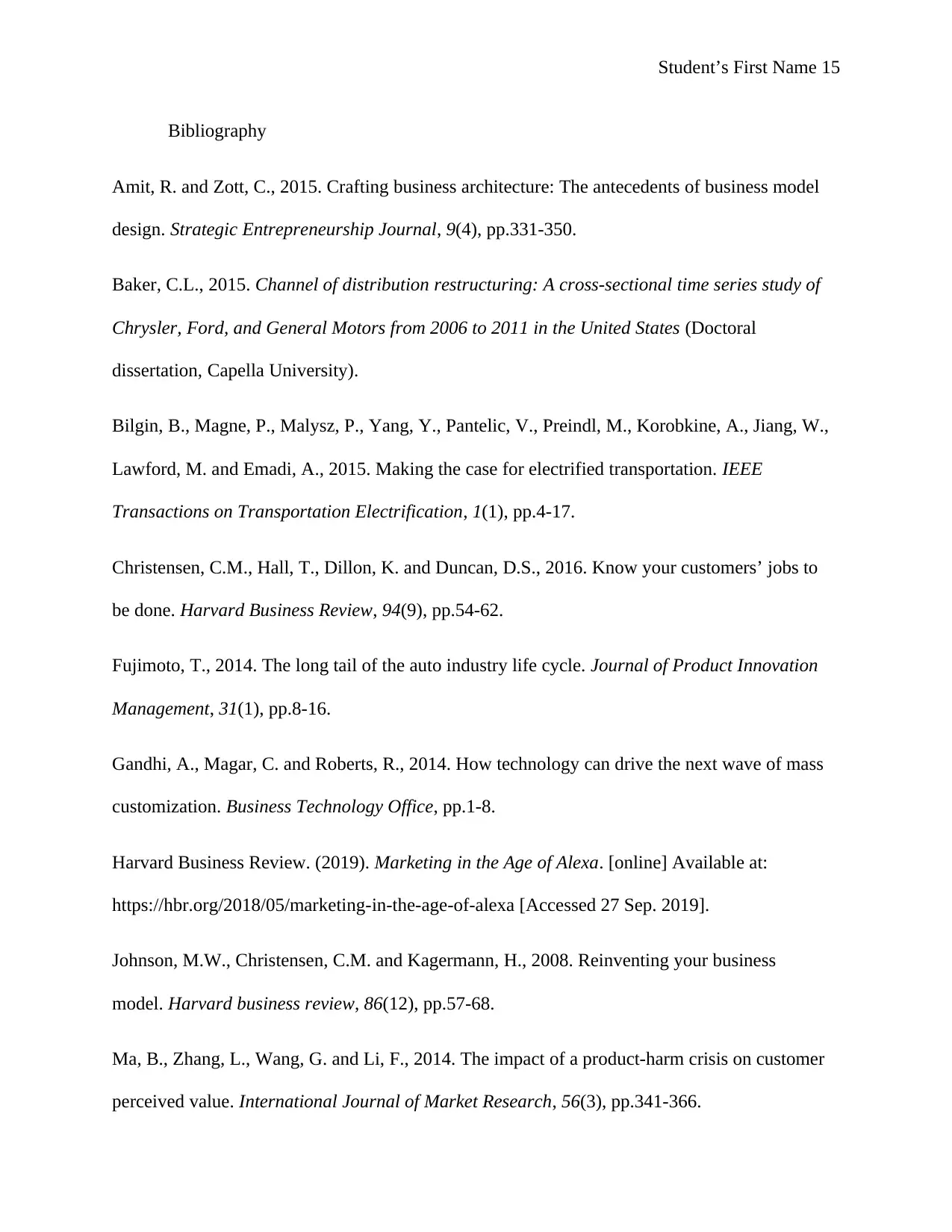
Student’s First Name 15
Bibliography
Amit, R. and Zott, C., 2015. Crafting business architecture: The antecedents of business model
design. Strategic Entrepreneurship Journal, 9(4), pp.331-350.
Baker, C.L., 2015. Channel of distribution restructuring: A cross-sectional time series study of
Chrysler, Ford, and General Motors from 2006 to 2011 in the United States (Doctoral
dissertation, Capella University).
Bilgin, B., Magne, P., Malysz, P., Yang, Y., Pantelic, V., Preindl, M., Korobkine, A., Jiang, W.,
Lawford, M. and Emadi, A., 2015. Making the case for electrified transportation. IEEE
Transactions on Transportation Electrification, 1(1), pp.4-17.
Christensen, C.M., Hall, T., Dillon, K. and Duncan, D.S., 2016. Know your customers’ jobs to
be done. Harvard Business Review, 94(9), pp.54-62.
Fujimoto, T., 2014. The long tail of the auto industry life cycle. Journal of Product Innovation
Management, 31(1), pp.8-16.
Gandhi, A., Magar, C. and Roberts, R., 2014. How technology can drive the next wave of mass
customization. Business Technology Office, pp.1-8.
Harvard Business Review. (2019). Marketing in the Age of Alexa. [online] Available at:
https://hbr.org/2018/05/marketing-in-the-age-of-alexa [Accessed 27 Sep. 2019].
Johnson, M.W., Christensen, C.M. and Kagermann, H., 2008. Reinventing your business
model. Harvard business review, 86(12), pp.57-68.
Ma, B., Zhang, L., Wang, G. and Li, F., 2014. The impact of a product-harm crisis on customer
perceived value. International Journal of Market Research, 56(3), pp.341-366.
Bibliography
Amit, R. and Zott, C., 2015. Crafting business architecture: The antecedents of business model
design. Strategic Entrepreneurship Journal, 9(4), pp.331-350.
Baker, C.L., 2015. Channel of distribution restructuring: A cross-sectional time series study of
Chrysler, Ford, and General Motors from 2006 to 2011 in the United States (Doctoral
dissertation, Capella University).
Bilgin, B., Magne, P., Malysz, P., Yang, Y., Pantelic, V., Preindl, M., Korobkine, A., Jiang, W.,
Lawford, M. and Emadi, A., 2015. Making the case for electrified transportation. IEEE
Transactions on Transportation Electrification, 1(1), pp.4-17.
Christensen, C.M., Hall, T., Dillon, K. and Duncan, D.S., 2016. Know your customers’ jobs to
be done. Harvard Business Review, 94(9), pp.54-62.
Fujimoto, T., 2014. The long tail of the auto industry life cycle. Journal of Product Innovation
Management, 31(1), pp.8-16.
Gandhi, A., Magar, C. and Roberts, R., 2014. How technology can drive the next wave of mass
customization. Business Technology Office, pp.1-8.
Harvard Business Review. (2019). Marketing in the Age of Alexa. [online] Available at:
https://hbr.org/2018/05/marketing-in-the-age-of-alexa [Accessed 27 Sep. 2019].
Johnson, M.W., Christensen, C.M. and Kagermann, H., 2008. Reinventing your business
model. Harvard business review, 86(12), pp.57-68.
Ma, B., Zhang, L., Wang, G. and Li, F., 2014. The impact of a product-harm crisis on customer
perceived value. International Journal of Market Research, 56(3), pp.341-366.
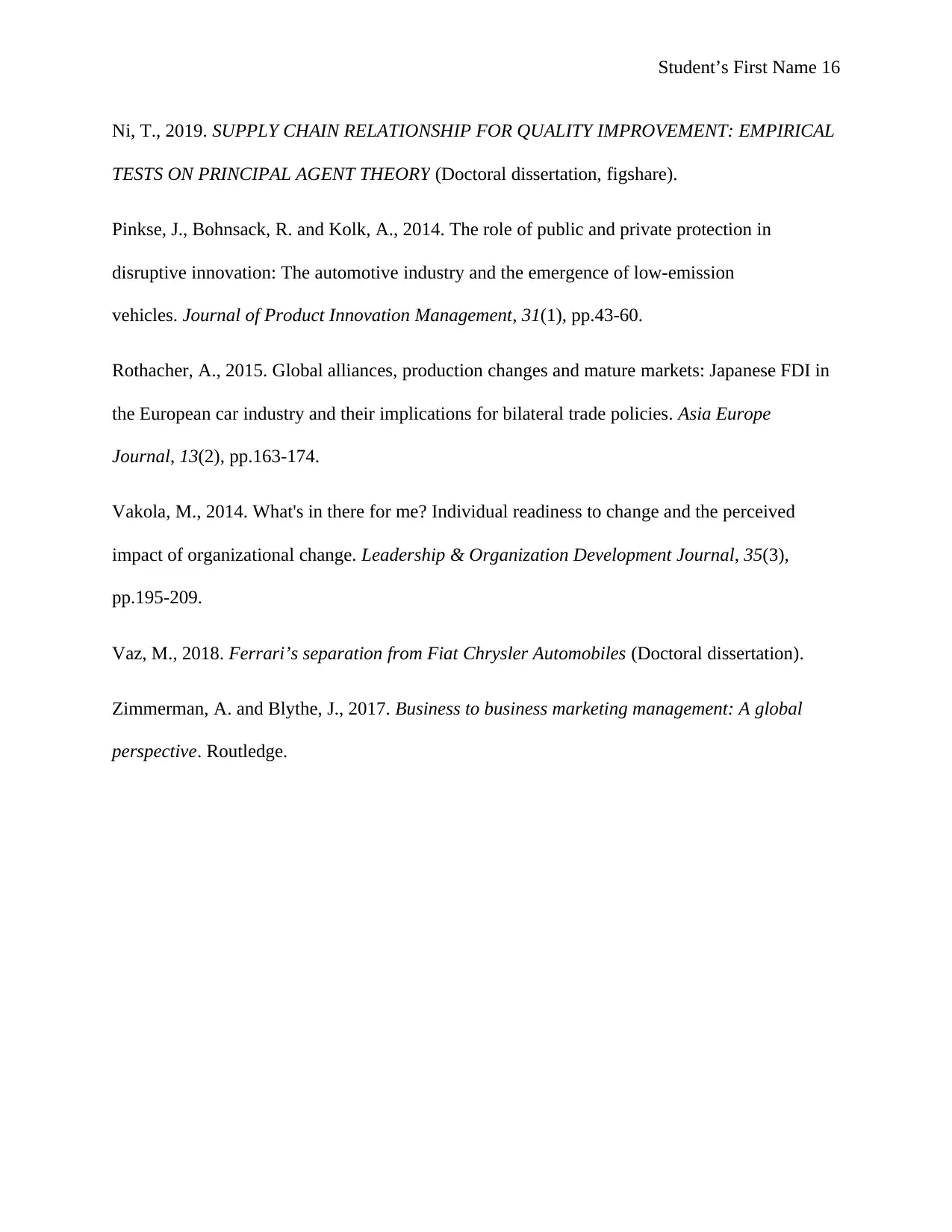
Student’s First Name 16
Ni, T., 2019. SUPPLY CHAIN RELATIONSHIP FOR QUALITY IMPROVEMENT: EMPIRICAL
TESTS ON PRINCIPAL AGENT THEORY (Doctoral dissertation, figshare).
Pinkse, J., Bohnsack, R. and Kolk, A., 2014. The role of public and private protection in
disruptive innovation: The automotive industry and the emergence of low‐emission
vehicles. Journal of Product Innovation Management, 31(1), pp.43-60.
Rothacher, A., 2015. Global alliances, production changes and mature markets: Japanese FDI in
the European car industry and their implications for bilateral trade policies. Asia Europe
Journal, 13(2), pp.163-174.
Vakola, M., 2014. What's in there for me? Individual readiness to change and the perceived
impact of organizational change. Leadership & Organization Development Journal, 35(3),
pp.195-209.
Vaz, M., 2018. Ferrari’s separation from Fiat Chrysler Automobiles (Doctoral dissertation).
Zimmerman, A. and Blythe, J., 2017. Business to business marketing management: A global
perspective. Routledge.
Ni, T., 2019. SUPPLY CHAIN RELATIONSHIP FOR QUALITY IMPROVEMENT: EMPIRICAL
TESTS ON PRINCIPAL AGENT THEORY (Doctoral dissertation, figshare).
Pinkse, J., Bohnsack, R. and Kolk, A., 2014. The role of public and private protection in
disruptive innovation: The automotive industry and the emergence of low‐emission
vehicles. Journal of Product Innovation Management, 31(1), pp.43-60.
Rothacher, A., 2015. Global alliances, production changes and mature markets: Japanese FDI in
the European car industry and their implications for bilateral trade policies. Asia Europe
Journal, 13(2), pp.163-174.
Vakola, M., 2014. What's in there for me? Individual readiness to change and the perceived
impact of organizational change. Leadership & Organization Development Journal, 35(3),
pp.195-209.
Vaz, M., 2018. Ferrari’s separation from Fiat Chrysler Automobiles (Doctoral dissertation).
Zimmerman, A. and Blythe, J., 2017. Business to business marketing management: A global
perspective. Routledge.
1 out of 16
Related Documents
Your All-in-One AI-Powered Toolkit for Academic Success.
+13062052269
info@desklib.com
Available 24*7 on WhatsApp / Email
![[object Object]](/_next/static/media/star-bottom.7253800d.svg)
Unlock your academic potential
© 2024 | Zucol Services PVT LTD | All rights reserved.





